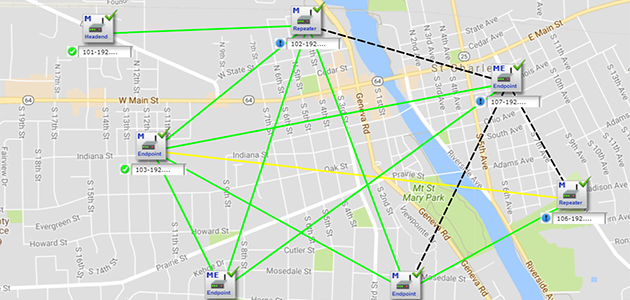Optimizing Field Area Networks for Grid Reliability
Back to Top
Many utilities rely on wireless field area networks for SCADA and distribution automation. Reliable communication is necessary to enable these applications, in turn providing reliable power to utility customers. Periodic optimization of field area networks is essential for the long-term viability of the network and the applications it supports. Increased vegetation and new buildings obstructing line-of-sight propagation of radio signals, as well as increased interference levels in the unlicensed radio bands, can all affect radio network performance. If neglected, critical messages during a fault could fail, resulting in longer power outages for more customers.
A successful optimization project starts with assembling the right team from a cross-section of stakeholders—from IT to SCADA operators. When planning begins, the team should establish goals and key performance indicators (KPIs) to gauge project success.
Some common optimization goals are improving SCADA response times and devices that are out of scan. For large networks, it’s best to focus on targeted network segments. If this is your first optimization project, choosing a network segment with no need for major performance improvements allows you to test a methodology that can later be applied to more challenging segments.
Once you’ve decided on the project scope and assigned roles, you should take inventory of available data and evaluate additional data needs and data-collection tools. SCADA and enterprise software, like network management systems, provide most of the performance data. However, suboptimal networks may have connectivity issues that preclude remote data collection.
At times, hardware may need to be replaced so data can be collected across the entire network. Field tools, including truck radios, spectrum analyzers, and bucket trucks, should be available to field crews so they may collect additional and missing data. The team should also have radio path profiling tools so they can validate the existing network design. These tools can save time and effort if coverage related design changes are needed.
Once the team has a plan and has put the right tools in place, the utility can begin the data-collection phase of the project to establish baseline performance. Historical data should be analyzed to identify problems and help set goals, but this baseline data should be collected under controlled network conditions, including traffic from individual and simultaneous applications, to understand how each affects network performance.
Next is the network-analysis phase, where data are analyzed relative to the KPIs to produce recommendations for optimizing network performance. This work requires expertise in data analytics, wireless network design, and performance analysis of specific communication and grid technologies.
Then comes the network-optimization phase, where the recommended optimization improvements are executed. The network management system enables utilities to perform many optimization tasks remotely and provides situational awareness of the effect of optimization changes. This may include firmware upgrades and changes to configuration settings that affect how nodes in the network interact with each other.
As changes are implemented, a lower level of issues may arise that were masked by the original issues. Some changes may not yield the intended result immediately.
Periodic network monitoring and performance assessment is recommended as an ongoing process. While preventative maintenance and continuous monitoring will help to prolong the benefits of an optimization project, it’s best to undertake a rigorous optimization project every year or two to ensure long-term network viability.
I’d be interested in hearing about how well your utility’s optimization efforts are doing in the Comments section below.